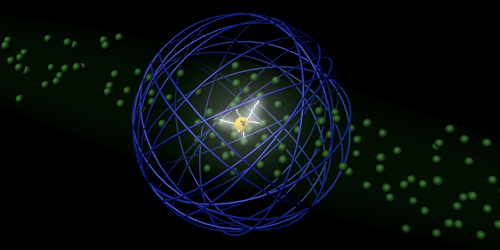Fitting a Bose-Einstein Condensate inside an Atom
Researchers routinely trap either atoms or ions at ultralow temperatures to investigate exotic quantum phenomena. However, current schemes for trapping both ions and atoms in the same experiment can only reach temperatures in the millikelvin range, not nearly low enough to observe many quantum phenomena arising from ion-atom interactions. Now Kathrin Kleinbach at the University of Stuttgart in Germany and co-workers have demonstrated a new approach for studying the interaction of an ion with a cloud of atoms at temperatures below 1 K.
The authors’ idea was to use a neutral Rydberg atom—an atom whose outermost electron is excited to a very high quantum number—instead of an ordinary ion. The researchers prepared a cigar-shaped Bose-Einstein condensate (BEC) of about 65,000 rubidium atoms and then excited the outermost electron of one of these atoms to a state with a quantum number of up to 190. This excited electron orbited with a mean radius of about 4 m, which was larger than the short axis of the BEC cloud. So the ionic core of the Rydberg atom acted like an ion interacting with the BEC, while the Rydberg electron orbited mainly outside of the BEC. What’s more, the Rydberg electron functioned as a Faraday cage that screened out stray electric fields that could interfere with the experiments.
The team showed that the interaction between the ionic core and the BEC could be probed by monitoring the shape of the absorption lines of the Rydberg atom. Such a system could allow researchers to study quantum effects associated with collisions, interactions, and chemical reactions between ions and neutral atoms.
This research is published in Physical Review Letters.
–Matteo Rini
Matteo Rini is the Deputy Editor of Physics.





